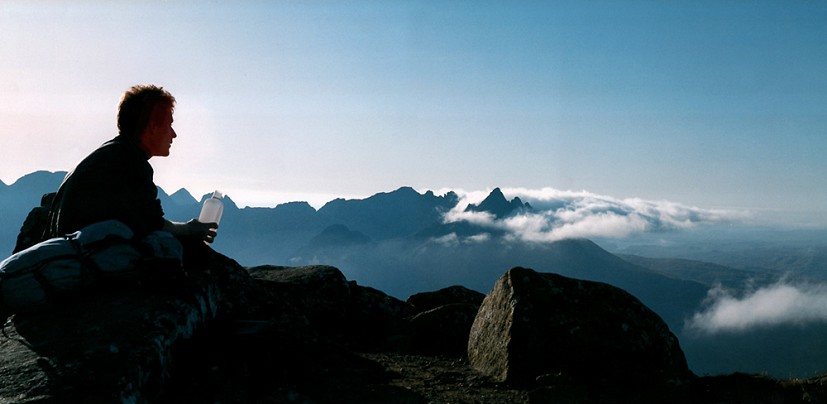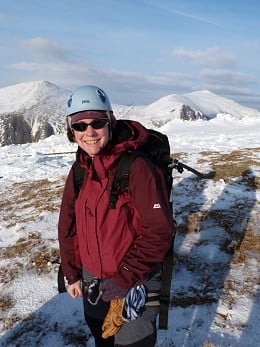Hyperthermia - Heat Illnesses and How to Manage Them
Summer weather on the hills can easily catch you out. We recently covered hydration, so now it's time to take a more in-depth look at the symptoms and treatment of heat illnesses, with mountain first aid expert Helen Howe.
In the hottest summer in recent times and with dwindling water supplies, it is good for us all to be aware of the dangers of heat in the outdoors especially with longer days and walkers wanting to make the most of the longer daylight hours and do bigger hill days.
Fortunately Heatstroke is relatively rare (I have only dealt with one definite case as a Mountain Rescuer, and only a handful of Heat Exhaustion Casualties) as most people realise they feel too hot and then react by resting, drinking, seeking shade and taking layers off.
The most well documented and publicised case in the media is the SAS Selection, where three potential SAS recruits collapsed and died on a training exercise. Here there was a goal which made them push past their limit as can happen in competitive events such as marathons and triathlons.
Heat Illnesses
The opposite of hypothermia, in which body temperature drops below that required to maintain normal metabolism, hyperthermia is the name for elevated body temperature that results when the body's usual thermoregulation fails. This can become a medical emergency, and may even lead to death.
There are several heat and sun-related conditions to be aware of:
- Heat exhaustion (mild hyperthermia)
- Heat stroke (severe hyperthermia)
- Hyponatraemia (water intoxication)
The first two conditions can be caused by raised body temperature and dehydration. One is reversible and treatable in the field, the other is not. It is useful for us to know the signs and symptoms of each and to know how to treat or manage the casualty. The third condition is as a result of extreme drinking as a response to heat and/or exercise.

Causes and contributory factors
It is worth being aware that sometimes hyperthermia can occur when temperatures are not extreme, due to dehydration and mismanagement. The following are a list of things that can cause or increase the risk of hyperthermia:
- Inappropriate clothing (too much/too little)
- Warm temperatures
- Age (older and younger)
- Dehydration
- Certain medical conditions e.g. high blood pressure, diabetes,
- Certain medications
- Competition e.g. races.
Heat Exhaustion - what to look for:
At this stage the casualty looks and feels hot. They may be sweating profusely and have hot, flushed skin. They feel thirsty and have a headache and may feel slightly nauseous.
Heat exhaustion – what to do:
Heat exhaustion is reversible! This is the stage at which to act. You can make a difference.
- Give drinks in sips so as to rehydrate the casualty but not to make them sick.
- Actively cool them down. Wet clothing is very effective but resist the temptation to dunk them in streams or lakes as this can be very dangerous and induce cold water shock syndrome which could kill them. Fanning them and getting out of the sun into shade is extremely beneficial.
- Paracetamol for headaches can help but it is better not to use ibuprofen as this can cause kidney problems in anyone who is seriously dehydrated.
Heat Stroke - what to look for:
At this stage the casualty has usually sweated out, and so they may be dry to touch and hot and flushed. However they can also be dry but look pale as they have entered shock from fluid loss through sweating. Their heartbeat may be rapid and weak and they may actually complain of feeling cold and be shivering (think about the last time you had flu or a fever and remember how, despite your body temperature being raised, you felt cold and shivery).
Often at this stage the casualty stops sweating and can vomit. Either of these are really bad signs and you have got a medical emergency on your hands.
The casualty often undergoes character change and may become confused, aggressive or irritable. If left untreated they may collapse and lose consciousness.
Heat Stroke – what to do:
Make no mistake about it: Heat stroke is a killer and can develop extremely rapidly. As it the name 'stroke' suggests, brain damage can occur and in some cases this will be irreversible.
- Call 999 for emergency help.
- Again try to cool the casualty using the methods above (although at this stage you are not really going to cool down their core temperature but you may help prevent them getting any hotter.)
- If you can get them to drink sips of fluids it may help but remember they may well vomit.
- Try to get them in the shade.
- Be prepared to place in a Safe Airway Position should they become unconscious and monitor closely being ready to start CPR if needed.
It is important to hydrate enough but not too much. This can be a delicate balance. It is based on amount of activity and duration, temperature and body size. There are ways of working out how much to drink here.
With drinks for the mountains, consider watered down orange juice, electrolyte drinks for some of your fluid (you can make your own with flavoured Vitamin tablets, salt and sugar/glucose and with lemon, lime and orange squeezed into it). Again google different recipes.
A filtration device is also a useful extra in this weather as the streams are becoming stagnant. They are now small enough and some are designed to screw onto normal plastic bottles such as the Sawyer Mini.
Water Intoxication:
Fortunately a rare condition in humans although becoming more frequent among amateur triathletes and marathon runners. This occurs when someone literally drinks too much water, and ends up flushing the salts out of their kidneys. It is as deadly as Heat Stroke and displays many similar symptoms. It can also cause a rapid deterioration.
Water intoxication, also known as Hyponatraemia, is a serious medical emergency and perhaps is more recognised or common in dogs who play in water in the hot weather so swallowing lots of H2O. However is does occur in humans who are drinking lots of water, rather than other fluids with minerals, in hot weather. In order to avoid it drink fluids with electrolytes such as sports drinks and eat salty foods such as salted nuts and crisps while walking/running.
- Suspected hyponatraemia is a 999 response! Be prepared to place in Safe Airway Position and start CPR.
Table comparing signs and symptoms of the different conditions:
| Heat Exhaustion | Heat Stroke | Hyponatraemia |
|---|---|---|
| Looks and feels hot | Hot, dry skin or pale, cold skin and extremities | Nausea |
| Headache | Severe headache | Vomiting |
| Thirsty | Nausea and vomiting | Headache |
| Sweating | Usually stopped sweating | Short term memory loss |
| Nausea | Dark pee if they can urinate | Confusion |
| Fatigue, weakness, lethargy | Confusion | Fatigue, lethargy |
| Loss of appetite | Delerium | Irritability |
| Mild confusion | Rapid short breaths | Loss of appetite |
| Dizziness | Weak rapid pulse | Muscle weakness, cramps |
| Stomach, arm and/or leg cramps | Fitting (seizures) | Seizures |
| Increased breathing and pulse | Loss of consciousness | Loss of Consciousness |
| Children can become sleepy or floppy | Heart stops | Sweating |
| Moist membranes such as in mouth | ||
| Pee is pale in colour |
About Helen Howe
Helen runs Snowdonia First Aid with her husband Steve.
Each have over twenty years of Scottish winters and are qualified Winter and International Mountain Leaders. They run Outdoor First Aid courses and Mountain Leader Training and Assessments as well as mountain and hill skills courses. This winter Helen and Steve are running Winter Skills courses both in Snowdonia and Scotland.
Helen is also a qualified Mountain Rescue Dog handler who has trained three SARDA dogs. Both she and Steve are active members of Llanberis Mountain Rescue Team and have served on the Medical and Training Sub committees running some of the team's winter training.

